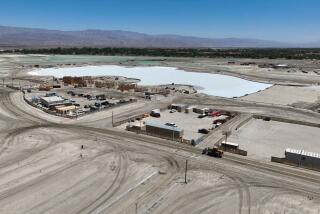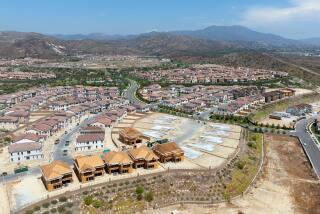City at the Center
- Share via
Three decades ago, Linda Molthen had a clear sense of deja vu as she and her husband, Doc, a chiropractor, drove their car up a two-lane road and into a new housing tract in the city of Cerritos.
Three dairy farms and a turkey ranch surrounded their future home, recalled Molthen, a caterer, who was raised in a little farming town in the Midwest.
For the record:
12:00 a.m. May 24, 1998 For the Record
Los Angeles Times Sunday May 24, 1998 Home Edition Real Estate Part K Page 2 Real Estate Desk 1 inches; 24 words Type of Material: Correction
In the May 17 “At Home” profile of Cerritos, the business of one of the residents was incorrectly reported. John Dickerson runs an automotive restoration business in Downey.
Then living in Huntington Park, the Molthens had been looking at houses in Downey and Lakewood when their accountant told them they could get into one of those homes going up “out in Cerritos” for practically nothing.
“They were going to let you come in with 5% down, the builder was going to carry 5% and the bank was going to finance 90%,” Molthen said. “It was almost a dream come true.” They paid $24,500 for their first home.
“I thought, ‘This is great. We’re going to raise our kids in the country.’ And it’s not that far from downtown Los Angeles,” Molthen said.
Now fast-forward to 1997. In the light-filled living room of her 3,000-square-foot home- the couple paid $48,000 for a larger house in the community in 1973--Molthen reels off some of the changes that have taken place.
One of the dairy farms is now the Los Cerritos Center, with a Macy’s, Nordstrom’s, Sears and Robinsons-May; one of the others became Bragg Elementary School. Scholastically renowned Whitney High School soon followed.
The 100-acre Towne Center, which combines office, retail and hotel facilities and the Cerritos Center for the Performing Arts, occupies the site of the former turkey ranch.
Like most longtime residents, she considers the dramatic pace of progress with good-natured pride. “We have just been really lucky that we have been in the area where a lot of people have wanted to live,” Molthen said.
Lying along the Los Angeles-Orange County line, Cerritos is bounded by Norwalk and Santa Fe Springs on the north; Lakewood on the south and west; and La Palma, Buena Park and La Mirada on the east. Interestingly, Cerritos forms a U shape around the incorporated city of Artesia.
Cerritos has been called the virtual geographic center of the Los Angeles Basin, and its proximity to three freeways--the 605, 91 and 5--places commuters within a half-hour’s reach of downtown Los Angeles, Long Beach and Anaheim.
The city gets name recognition from such landmarks as the Cerritos Center for the Performing Arts and the Cerritos Auto Square, the world’s largest auto mall.
The city was thrust into headlines in 1986 when an Aeromexico DC-9 approaching LAX struck a light plane over Cerritos, killing 80 people, including 15 on the ground, and setting 16 homes on fire.
The city of 53,000 is the most ethnically diverse community of its size in the United States, according to a study conducted by Cal State Northridge. Asians make up 44% of the population; whites, 35.8%; Latinos and blacks, 12.5% and 7.2%, respectively.
Robin Wang was familiar with Cerritos from many business trips and saw the city as “my only choice” when he and his wife, Sally, emigrated from Taiwan in 1995.
*
As Wang was about to make a job change, he thought the city’s location would increase his employment opportunities. “Cerritos is located in the central part of the whole Los Angeles area,” said Wang, who works for an optical frame importing company in Monterey Park.
The education of his 11-year-old daughter, Jessica, was also a high priority. “I had many friends here who told me [Cerritos] had a good school district,” Wang said.
The Wangs, who started out renting in Lakewood, spent almost a year and a half in search of their four-bedroom, 1 3/4-bath house.
What took them so long, he explained, was their desire for a newly built house--a preference not easily accommodated in Cerritos, where vacant land is scarce and the homes are usually somewhat older.
But last March they found a 27-year-old house that Sally Wang, who works in cosmetics sales, loved for its brightness. They paid $222,000 and, before moving in, put in new carpets and tiles and had the bedrooms and kitchen remodeled.
The Wangs’ appreciation of Cerritos also includes its safety. “I found there are so many policemen in Cerritos,” Wang said. “Families are safe. You can walk [and] within 10 minutes reach a park. . . . That is very important.”
The Cerritos housing market covers a broad price range, said Olympia Chen, an agent for Century 21-Inland Pacific. Condos start at $80,000, she said.
The median price for a four-bedroom, two-bath two-story house at 1,800 to 2,000 square feet is $250,000, she said.
The most expensive housing was built about five years ago. These semi-custom homes, 4,000 square feet in size and English Tudor in style, sell in the $750,000 range.
Top-flight schools have helped make Cerritos a desirable place to live, said Thomas Riley, superintendent of the ABC School District.
“Eighty-five percent of our students go on to colleges and universities,” Riley said, “and 98% of our youngsters leave third grade reading at their grade level.”
So sure was Riley of the city’s appeal and the strength of its housing market that he urged the district in 1996 to form a partnership with Warmington Homes to develop 13 acres of surplus land next to Whitney High School.
The development--61 homes, each priced at about $300,000--sold out on the first day of sales, bringing the district about $7 million.
“Districts going into partnership doesn’t happen too often,” Riley said, “but we knew the homes would sell.”
Some four decades ago, the future city of Cerritos was home to more than 400 dairies and 4,300 residents. It was called Dairy Valley.
The city was incorporated in 1958 and in 1967 changed its name to Cerritos, from the Spanish land grant Rancho Los Cerritos.
In a young city surrounded by open land, those first council representatives had the power to dictate the path of development. They were supported by a like-minded populace who wanted to control growth and protect the quality of life, Mayor Bruce Barrows said.
And they were lucky. “We were in the right place at the right time,” Barrows said.
What has grown up over the years has been a well-planned city of tree-lined tracts of single-family homes set apart from the city’s commercial and light industrial sectors by greenbelts and low walls.
The city also has a far-reaching and rigorously enforced building code.
“You’d have a difficult time painting your house an unusual color,” said John Dickerson, a 17-year homeowner who owns a furniture refinishing business in Downey.
And while he thinks it might be nice to “live next door to a neat Victorian,” the lack of architectural diversity has in no way dampened the pleasure Dickerson and his wife, Cathy, share in their 1,500-square-foot three-bedroom house, for which they paid $140,000 in 1980. “The vaulted ceilings make the house look larger than it really is,” said Cathy Dickerson, a hair stylist. “We have all glass in our bedroom, which looks out onto our patio, and the windows in our dining room are so large that we get to enjoy our backyard.”
While the couple think Cerritos could use a few more special-occasion restaurants, the performing arts center gets unreserved praise.
“We can walk,” said Cathy Dickerson. “If we drive, we can get there in five minutes. It’s a small, intimate theater that attracts some very nice entertainment. It’s just really neat.”
More to Read
Inside the business of entertainment
The Wide Shot brings you news, analysis and insights on everything from streaming wars to production — and what it all means for the future.
You may occasionally receive promotional content from the Los Angeles Times.










